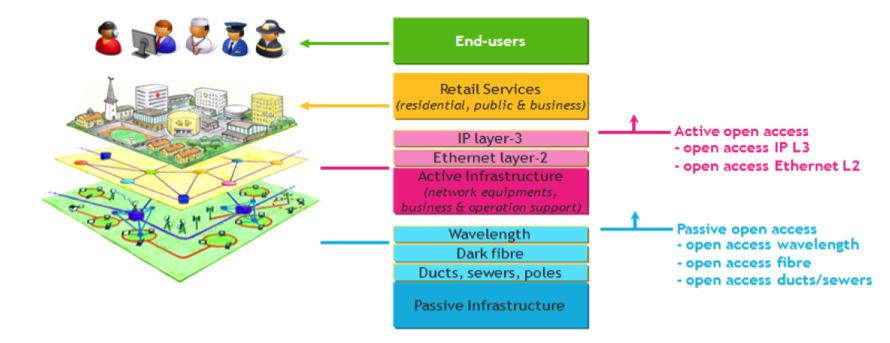This chapter on the state of network infrastructure in Alberta draws on publicly available information and input from a range of stakeholders in the Canadian and provincial internet community. It will review publicly and privately funded network infrastructure, the availability of a range of broadband services, innovations in broadband delivery technologies, and the changing regulatory landscape.
Background
Broadband internet is the high-speed and high-capacity transmission of internet data over a network (e.g. fibre optic cables).source4 The global internet is comprised of many independent but interconnected networks. Consumers connect to local or regional ISPs through access networks (called the ‘first or last mile’) that can be wireline (fibre optic or copper cables) or wireless (satellite or tower-based). Fibre-to-the-home or premise supports the highest internet bandwidth speeds (> 1 Gbps), as shown in Figure 1. Consumers purchase internet access from regional Internet Service Providers (ISPs), who in turn acquire internet access from larger upstream ISPs (e.g. a Tier 1 network).
Figure 1. Carrying Capacities of Broadband Access Solutions (Adapted from Broadband Communities Magazine5)
Connections from a local access network to the global internet take place via a middle mile network. In the context of rural communities, the “middle mile” is the connection to a larger metropolitan centre. The Alberta SuperNet is one example of middle mile infrastructure. Backhaul networks then connect the middle mile to a major internet exchange or the core portion of a provider’s network. Middle mile and backhaul connections are almost always fibre-based, due to the large bandwidth requirements these connections must support.
The physical network infrastructure can provide broadband services according to a number of access models, based on who controls the various network layers:
Physical Infrastructure Layer — ducts, pipes, and fibre optics
- Network Provider Layer — active equipment such as routers and switches
- Service Provider Layer — internet services
Depending on whether one or more organizations control the above layers, different access models are used to deliver broadband services, leading to either infrastructure- or services-based competition. Infrastructure-based competition means each service provider has to own and operate all layers of the network. In order to enter this market, a new service provider has to build its own network infrastructure. In services-based competition, service providers leverage common physical infrastructure in order to deliver broadband services. This is predicated on open access networks that provide fair and non-discriminatory access to the underlying layer(s) for all service providers. This access would either be at the network provider or physical infrastructure layer (Figure 2).
Figure 2. Network layers and types of open access networks. Source: Fibre to the Home Council Europe. FTTH Handbook - Edition 7. Feb. 16, 2016.
While download speeds are the most commonly cited attribute reflecting broadband quality, access to symmetric bandwidth is becoming increasingly important. Symmetric bandwidth means the upload speed is as fast as the download speed. Currently in Alberta, symmetric bandwidth is not the norm, as most commercial internet packages provide upload:download ratios ranging between 1:30 and 1:5. In order to participate in the digital economy and take advantage of the growing number of cloud services available, it is expected that creating and uploading content to the internet will take on a larger role. This in turn will put greater demand on improving access to higher upload speeds.
References
4. Wikipedia. Broadband article. Accessed 19 June 2016.
5. Broadband Communities Magazine. The FTTH Primer. Accessed 27 July 2016.
6. Fibre to the Home Council Europe. FTTH Handbook - Edition 7. Feb. 16, 2016.
